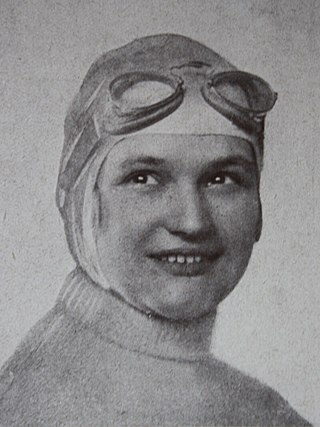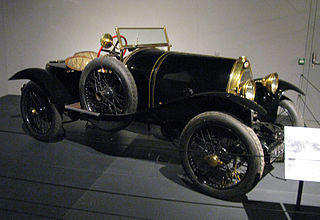
Automobiles Ettore Bugatti was a German then French manufacturer of high-performance automobiles. The company was founded in 1909 in the then-German city of Molsheim, Alsace, by the Italian-born industrial designer Ettore Bugatti. The cars were known for their design beauty and numerous race victories. Famous Bugatti automobiles include the Type 35 Grand Prix cars, the Type 41 "Royale", the Type 57 "Atlantic" and the Type 55 sports car.

Eliška Junková-Khásová, also known as Elisabeth Junek, was a Czechoslovak automobile racer. She is regarded as one of the most significant drivers in Grand Prix motor racing history, and was the first woman to win a Grand Prix event.

The Bugatti Type 13 was the first true Bugatti car. Production of the Type 13, and later Types 15, 17, 22, and 23, began with the company's founding in 1910 and lasted through 1920, with 435 examples produced. Most road cars used an eight-valve engine, though five Type 13 racers had 16-valve heads, some of the first ever produced. The road cars became known as pur-sang ("thoroughbred") in keeping with Ettore Bugatti's feelings for his designs.

The Bugatti Type 35 is an iconic race car design produced by Bugatti at their Molsheim premises between 1924 and 1930. It was extremely successful when raced by the factory works team. It was also bought by a diverse roster of privateer clientele from around the world. It pioneered the concept of a holistically conceived, race-ready car available for purchase.

The Bugatti Type 51 series succeeded the famous Type 35 as Bugatti's premier racing car for the 1930s. The main distinction is that it uses a twin cam engine. Unlike the dominant Type 35s of the prior decade, the Type 51 were unable to compete with the government-supported German and Italian offerings.

The Bugatti Type 18, also called the Garros, is an automobile produced from 1912 through 1914. Produced shortly after the start of the business, the design was something of a relic. It had much in common with the cars Ettore Bugatti had designed for Deutz Gasmotoren Fabrik but with the radiator of the Type 13. Only seven examples were built, and three are known to survive.

The Bugatti Type 41, better known as the Royale, is a large luxury car built by Bugatti from 1927 to 1933, With a 4.3 m (169.3 in) wheelbase and 6.4 m (21 ft) overall length, it weighs approximately 3,175 kg (7,000 lb) and uses a 12.763 litre (778 cu in) straight-eight engine. For comparison, against the Rolls-Royce Phantom VII, the Royale is about 20% longer, and more than 25% heavier. This makes the Royale one of the largest cars in the world. Furthermore, with the limited production run and the premium nature of the vehicle, it is also both one of the rarest and most expensive.

The Bugatti Type 32, commonly called the Tank de Tours, was a streamlined racing car built in 1923. It was built to compete in the French Grand Prix, which was held on July 2 in Tours on the same year.

Sir Henry Ralph Stanley Birkin, 3rd Baronet, known as Tim Birkin, was a British racing driver, one of the "Bentley Boys" of the 1920s.

The Shelsley Walsh Speed Hill Climb is a hillclimb in Shelsley Walsh, Worcestershire, England, organised by the Midland Automobile Club (MAC). It is one of the oldest motorsport events in the world, and is the oldest to have been staged continuously on its original course, first having been run in 1905. On that first occasion, the course was 992 yards in length, but in 1907 it was standardised at 1000 yards, the length it remains today.

The 1932 24 Hours of Le Mans was the 10th Grand Prix of Endurance that took place at the Circuit de la Sarthe on 18 and 19 June 1932. A significant year for the Automobile Club de l'Ouest (ACO) with the biggest changes to the circuit in the race's history. A new section bypassing Pontlieue suburb was built starting with a long right turn after the pits, going over a hill then down to the Esses, a left-right combination, before rejoining the Hunaudières straight at the new right-hand corner of Tertre Rouge. This shortened the track by almost 3 km down to 13.491 km (8.383 mi).

Julien Jean Chassagne was a pioneer submariner, aviator, and French racing driver active 1906–1930. Chassagne finished third in the 1913 French Grand Prix; won the 1922 Tourist Trophy and finished second in the 1925 Le Mans Grand Prix d'Endurance - all in Sunbeam motorcars. He was second in the 1921 Italian Grand Prix with a Ballot, and set speed records and won races at Brooklands and hill climbs internationally.

The 1932 Grand Prix season marked the second year of the AIACR European Championship. It saw the debut of Alfa Romeo's sensational new Tipo B and with it, Tazio Nuvolari won the Championship driving for the Alfa Corse works team. The 40-year old Nuvolari won two of the three rounds and was second in the other. Still running to a Formula Libre rules for the cars, the regulations were revised to set the races to be between five and ten hours. However, all three national committees ran their races to the minimum time-limit.
Four-wheel drive (4WD) has only been tried a handful of times in Formula One. In the World Championship era since 1950, only eight such cars are known to have been built.

The 1926 Grand Prix season was the second AIACR World Manufacturers' Championship season and the first running to new 1.5-litre regulations. The championship was won by Bugatti and its Type 35 was the dominant car of the year.

The 1927 Grand Prix season was the third AIACR World Manufacturers' Championship season and the second run to a 1.5-litre engine limit. In a dominant display, the championship was won by Delage, with team driver Robert Benoist winning four of the five Grand Prix.

In automotive design, an M4, or Mid-engine, Four-wheel-drive layout places the internal combustion engine in the middle of the vehicle, between both axles and drives all four road wheels.

The Auto Union Grand Prix racing cars types A to D were developed and built by a specialist racing department of Auto Union's Horch works in Zwickau, Germany, between 1933 and 1939, after the company bought a design by Dr. Ferdinand Porsche in 1933. The Auto Union type B streamlined body was designed by Paul Jaray.

László Hartmann was a Hungarian Grand Prix motor racing driver.


















